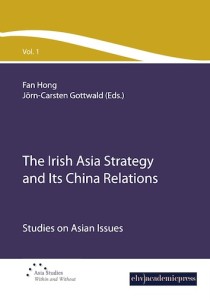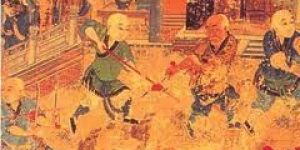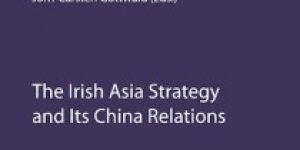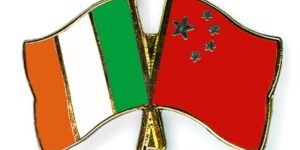Chapter 8: Promoting Irish Business In China – The Role Of The Government ~ The Irish Asia Strategy And Its China Relations
No comments yet The Irish Trade mission that arrived in Beijing on January 16th 2005 was led by the Taoiseach Bertie Ahern. The fact that he was accompanied by no less than four cabinet ministers (Minister Micheál Martin; Minister Mary Coughlan; Minister Mary Hanafin and Minister Noel Dempsey) served to underscore the importance of this particular mission. The trade mission visited Beijing, Shanghai and Hong Kong and, while the overall management and logistics for the business events were handled by Enterprise Ireland, many other state agencies and private industry associations participated in the mission in some way. Representatives of Irish agencies such as Bord Bia, Tourism Ireland and Shannon Development and members of associations such as IBEC, ISA, Chambers Ireland, and the Irish Exporters Association organised events, working closely with Enterprise Ireland to ensure the success of the visit.
The Irish Trade mission that arrived in Beijing on January 16th 2005 was led by the Taoiseach Bertie Ahern. The fact that he was accompanied by no less than four cabinet ministers (Minister Micheál Martin; Minister Mary Coughlan; Minister Mary Hanafin and Minister Noel Dempsey) served to underscore the importance of this particular mission. The trade mission visited Beijing, Shanghai and Hong Kong and, while the overall management and logistics for the business events were handled by Enterprise Ireland, many other state agencies and private industry associations participated in the mission in some way. Representatives of Irish agencies such as Bord Bia, Tourism Ireland and Shannon Development and members of associations such as IBEC, ISA, Chambers Ireland, and the Irish Exporters Association organised events, working closely with Enterprise Ireland to ensure the success of the visit.
This particular trade mission was in fact the largest ever organised in the history of the state until that time, involving a total of 121 Irish companies and institutions, primarily from in the ICT, Educational Services, Environmental and Engineering Services, Medical Devices and the Food and Drinks sectors. Around 300 Irish people (company executives and officials) travelled on what was an extremely successful but very complex mission. This event marked the culmination of the first stage of a process of engagement with China that had its origins some 6 years earlier – with the publication of the Asia Strategy in 1999.
Enterprise Ireland was set up in early 1998 through the merger of a number of other agencies (including Forbairt and the Irish Trade Board) and charged with responsibility for the overall development of Irish-owned industry. While within Ireland the organisation is involved in many aspects of the growth and development of Irish companies, a very important role of the agency involves the promotion of exports by Irish companies in overseas markets. Though the core of the overseas work involves making introductions for Irish executives to potential customers and partners and providing on-the-ground assistance in countries around the world, in the more distant markets, and especially in Asia, trade missions led by high level Government figures are very important in raising the image of Ireland generally – and of Ireland as a source of top quality products and services.
In late 1998 the Taoiseach had made his first official visit to China and Enterprise Ireland organised its first trade mission to accompany that visit. On that occasion only around 20 companies accompanied the official delegation. Given the recent developments in the China market it was obvious that Ireland’s overall level of engagement with the country was abysmally low and, following the visit, the Taoiseach requested a group of officials and private sector individuals to develop a coherent national strategy that would put Ireland on a stronger footing in terms of its overall relationship with Asia and with China in particular. The document that resulted from the deliberations of that committee was published in early 1999 as the Asia Strategy.
As the lead agency in terms of the development of Irish industry and the promotion of Irish exports, Enterprise Ireland was heavily involved in the development of the Asia Strategy – and its own plans for the growth of exports to Asia formed an integral part of the plans outlined in the published document.
Though the Irish Trade Board had initially established an office in Beijing in 1979, in the same year in which Ireland exchanged diplomatic relations with China, Irish exports to China were always at a low level due to the closed nature of the market and the difficulties faced by Irish companies in trying to access such a distant, different and under-developed market. By 1999 the situation was of course very different: China was developing rapidly and opening up to the global economy – and it was obvious that, in the years to come, the Chinese economy was going to continue to grow at a rapid pace. Following the publication of the Asia Strategy in 1999, Enterprise Ireland moved quickly to strengthen its operations in China, with offices in Beijing and in Shanghai (the two most developed cities in the country) and a further office in Hong Kong, which covered the southern part of the country, including the industrial powerhouse of Shenzhen.
In comparison with other countries in the EU Ireland has had very little history of engagement at a business level with China. While multinational companies with operations in Ireland always traded with Asia, this was to a large extent dictated by their global business strategies. In the early days of industrialisation in Ireland our larger companies, such as those in the food and drinks sectors were generally confined to selling into European and US markets. It was not until the development of new processing technologies and the growth of the software and services sectors that Irish industry acquired the right products and the economies of scale required to tackle the more distant markets in Asia. In addition, unlike countries such as the Netherlands and the UK that have companies that can trace their origins back to older national trading empires and that have had operations in Asia for many years, Ireland lacked a basic network in the region upon which to build new business.
8.1 Building the Business
The Enterprise Ireland team was charged with opening up the China market for Irish industry and with making contacts in local companies and organisations that would be useful to Irish companies – and also with encouraging more Irish companies to become familiar with the potential of that market.
As mentioned above, a major part of the work carried out in Enterprise Ireland’s overseas offices involves “matchmaking” for Irish business executives – setting up meetings with prospective business partners (local companies and local executives) for visiting Irish companies. However, given the low level of knowledge about China in Ireland at that time it was necessary to actually encourage more Irish companies to visit the market. Regular seminars were organised in various locations around Ireland with senior Irish executives speaking about their experiences in this very exciting market. Many trade delegations were organised to visit Ireland from China, allowing the Irish business community to establish links with Chinese business people and various media outlets were used wherever possible to promote the fact that China was now “open for business”.
In more recent years, the enormous media attention devoted to the phenomenal growth of China and its emergence as the “factory of the world” has obviated the need to publicise China within the Irish business community. Most Irish companies with products that can be exported to Asia have by now taken a serious look at the China market.
Within China itself, Enterprise Ireland initiated programmes to actively raise the awareness of Ireland through the Chinese media, organising journalists and TV crews to visit Ireland to produce features on Ireland in the Chinese media. Opportunities were sought to speak at various business events and it was decided to concentrate on the promotion of a number of business sectors where it was felt that Irish business had a competitive advantage in the China market.
Given the rapidly growing strength of China’s manufacturing sector and its very low cost-base, it was natural that the focus should be on promoting and selling the Irish service sectors, rather than on manufactured products. Awareness of Ireland as a leading source of software was growing within China and this was greatly helped by a visit made to Ireland by former Premier Zhu Rongji in September 2001. The team of economists that accompanied him compiled a report on Ireland’s IT sectors and they effectively spread the message within China that Ireland was a model for China to follow in the development of its own IT sectors. In the following years many Chinese people visited Ireland to see what could be learned about the software sectors and, from relationships developed in those years, a good number of Irish companies with strengths in the financial services, telecommunications and mobile applications software have since begun to prosper in the China market.
Education Services was also a focus of activity from the beginning of the Asia Strategy. Aside from the revenue generated from incoming students for the third-level institutions in Ireland and for the economy in general, Enterprise Ireland recognised that Chinese students completing their studies in Ireland could, when they returned to China, become a very important base of contacts upon which Irish trade could be expanded.
In recent years, as newly minted graduates are starting to return from Ireland, they are interested in keeping their links with Ireland. Enterprise Ireland has supported the formation of a number of local alumni associations to encourage these networks. Irish companies entering the China market can now find young executives who have a good understanding of Ireland – and in some cases even speaking with distinct Irish accents!
The massive infrastructure investments being made by the Chinese Government also attracted Engineering and Construction services companies from Ireland and other companies producing a wide range of high-tech products began to find new markets in China.
In moving from a command economy to a socialist market economy almost every aspect of the Chinese economy has gone through very dramatic change. In 1995 the country had over 200,000 state owned enterprises, most of which were loss-making or technically insolvent. By 2006 their numbers had been reduced to around 60,000. While some were reformed and later listed on the stock exchange and some were sold to local and foreign companies, many were simply shut down. In some years more than 12 million people lost their jobs in Chinese state owned companies, but due to the massive infrastructure projects underway across the country and the very rapid development of the newly liberalised private sectors, many of them were able to find new jobs. The growing need for power has driven the Central and Provincial Governments to invest heavily in new power generation projects across the country and the completion of the controversial Three Gorges Dam in 2007 was an indication of the capability of China’s new economy.
While the major cities along the east coast of China were the first to reap the gains of the liberalised markets, the Government was, and is, concerned that the new prosperity must reach the rural and western areas of the country – and in recent years much attention has been focused on bringing infrastructure and jobs to the central and western areas.
Because of the very low level of investment in the high technology sectors in the previous decades, China was able to move directly into the most modern technology available – without have to deal with the physical and financial burden of older legacy systems. For example, in the early 1980’s it was difficult to get a telephone in China but by 2007 China Mobile was the largest mobile telecommunications company in the world and internal growth in internet usage continues to lead the world.
8.2 Market Entry Issues
Given such explosive growth in everything from infrastructure to services the opportunities within the China market are enormous, but the market itself presents some unique and unusual difficulties for novice exporters.
Given the low level of English speaking ability in China, communications can pose an obvious problem for foreign business people. While there are lots of interpreter and translation services available in the major cities, unless the person hired to interpret has some understanding of business and can grasp the details of the foreign company’s offer they will be of little use: it is worthwhile spending time with the interpreter prior to any business meeting to explain the business fully. If it is possible the same interpreter should be used on all business visits.
A more subtle (and problematic) issue is that of local cultures, related to the size of the country. China covers a huge area and the internal regional cultural and language variations within the country are very diverse. Aside from the fact that more than 20 different languages and dialects are in use, business etiquette and culture varies enormously across the country. It is always best to use local advisors and interpreters from the province or city in which the business is being discussed and not to assume that a person employed in Beijing will be of any use to you in the Guangzhou market.
The vast scale of the country and the internal regional variations of the China market is something that shocks most first-time visitors. After spending some time in the market visitors quickly come to realise that China is a very complex country and should in fact be thought of as being somewhat similar to the expended EU, with all its regional and country-specific variations.
Trust is a major issue in doing business in China (and in Asia generally). People in China will do business with people they trust personally. Very little attention is paid to contracts or to the specific conditions contained in contracts. Business succeeds or fails based on people trusting each other; on delivering what they say they will deliver – and very importantly, on the ability to be flexible. To build trust between two people or two companies takes time – lots of time spent in company with the prospective partner(s), whether at banquets or dinners or (increasingly) on the golf course. The amount of time it takes to get to know someone personally may frustrate the occasional visitor to China but it is a vital aspect of the business process. Companies need to make a commitment to visit the market regularly over the first few years in order to create the necessary bonds.
In addition, for Chinese people nothing in business can be fixed or rigid – one needs to be prepared to change with changing conditions. To the uninitiated this can seem like continuous and interminable negotiation tactics and there is a common saying that in China “the negotiations start after the contracts are signed”. If one is prepared for this fact and one trusts their Chinese partner then this is just one more way to conduct business. Both sides are expected to be flexible. Trying to rigidly stick to written contracts simply does not work in China.
In order to conduct successful business in China (and in Asia-Pacific in general) it is very important to establish a local operation as soon as possible and, given the regional differences referred to above, it is usually not feasible to cover the whole China market from one office. Smaller companies are advised to focus on only one of the major centres in China such as Beijing, Shanghai or Guangzhou (all of which have populations in excess of 60 million in their hinterland) and to avoid looking at other areas until a successful foothold has been established
in that region.
One Enterprise Ireland initiative which has proved to be a big asset to incoming companies is the provision of incubator space in each of our local offices. Using these incubators as a short term base, Irish companies can test the market at a reasonable cost, before committing to the
establishment of an independent office.
Many Irish companies seek to enter China in a partnership with a local company and, while there are many Chinese companies eager to form such relationships, the process of selecting a local partner can present its own unique difficulties in China. Though many of the State-owned companies are eager to form partnerships with foreign companies, many are still suffering from the effects of the old command-style economy and are much slower to react to local business opportunities than the new private sector companies. On the other hand, many of the new start-up companies in China are still under-capitalised and, while they may seem to be very professional, they may be stretched financially and it is generally still not possible to do an accurate check on newer companies’ financial performance. Again, as mentioned above, it is vital to get to know the individuals involved on the Chinese side and to get a real understanding of their intentions. It is also very important to spend time in their factories and offices to get a good feeling for how well they run their operations.
For anyone entering the China market for the first time, a very basic “rule of thumb” is to avoid dealing with any company that is not already doing business internationally. Aside from the fact that it is much easier to get performance references, if they are already doing business with other international companies successfully, then they will have learned a good deal about what is expected by their foreign partners.
Finally, getting into the Chinese market takes resources in terms of management time and money and unless companies are prepared to spend at least one or two years on the effort it is simply not worth trying. However, most companies that have committed to the market have found the rewards they were seeking. China is a more open and unstructured market than many others in the developing world and the speed at which its economy is growing is astonishing.
8.3 Raising Awareness of Ireland
The focus provided by the Asia Strategy encouraged visits to China by a large number of senior political figures from Ireland in the early years of the decade, all of which helped to raise the awareness of Ireland. Where possible, Enterprise Ireland made good use of these visits to promote Irish exports. Following the initial 1998 trade mission, in 2000 Enterprise Ireland organised another mission (led by the then Tanaiste and Minister for Enterprise Trade and Employment Mary Harney) and later, in 2002, President McAleese’s State Visit to China was the occasion for a third mission.
The numbers associated with these missions are in themselves evidence of the growing Irish interest in China – and of increasing engagement by the Irish business community with China. While the initial 1998 mission attracted only around 20 companies, the 2000 mission involved 58 Irish companies. The mission organised around President McAleese’s State Visit attracted 85 participating companies – and the process culminated with the Taoiseach-led mission in January 2005 which brought 121 companies to China. Each of these events set records for participation by Irish companies in trade missions and provided many opportunities for the visiting executives to deepen their relationships with local customers and partners and to make new contacts across the country.
The accessibility of senior Irish Government figures during such missions is an important factor in their success. People in China very rarely have an opportunity to meet with, let alone talk to, their own top-level government officials. While it may not be seen as very important in the west, the opportunity for a photograph, or a discussion, with a country’s leaders is highly prized in China – and during these missions the President, Taoiseach, Tanaiste and Ministers were very generous with their time and their accessibility was valued highly by the participants.
The working relationship between the two Governments is also very important in setting the agenda for increasing trade. In the case of Ireland and China the relationship is very good and the focus provided by the Asia Strategy was important in this respect. Since 1999 a number of important bilateral agreements in areas such as Food, Education, Science and Technology and Tourism have been signed at Ministerial level, all of which have helped to develop a framework under which Irish companies can increase their business with China.
In the years since the Asia Strategy was published Ireland’s official presence on the ground in China has developed rapidly: A new consulate was opened in Shanghai in 2000 and agencies such as Tourism Ireland, IDA Ireland and Bord Bia (the Irish Food Board) have all established offices in the market.
Aside from the existing offices in Beijing, Shanghai and Hong Kong, Enterprise Ireland also established a fourth office in Guangzhou in 2004 to better service Irish business in the south of the country. Guangzhou is one of the wealthiest industrial cities in China and a very important centre of manufacturing. This office handles the majority of sub-contracting requests received by Enterprise Ireland.
The presence of so many official Irish offices has greatly helped to raise the awareness of Ireland in China and to assist Irish companies in developing their business in the market.
8.4 Trade with China
In the years since the publication of the Asia Strategy trade between the two countries has blossomed, as shown by data from the Irish Central Statistics Office. As with all Ireland’s trade statistics, these figures are dominated by the two-way trade of the large numbers of multinational companies with operations in Ireland and they do not truly reflect the position of Irish-owned companies, whose trade makes up only a small fraction of the total. In addition, these figures relate only to merchandise trade and do not account for trade in services, a rapidly growing sector of Irish business.
Ireland’s exports to China grew by over seven times from, € 119million in 1999 to € 876 million in 2006 while exports to Hong Kong grew to € 627 million in 2006, up from € 333 million in 1999. Given that most of what we export to Hong Kong is later transshipped to the mainland Chinese market the combined figure of somewhat over € 1.5 billion is a close approximation of Ireland’s exports to the China market as a while in 2006 (the last year for which the full year figures are available).
China’s exports to Ireland have shown even more remarkable strength over the same period, growing from € 656 million in 1999 to more than € 4.4 billion in 2006. While the balance of trade is strongly in China’s favour, this is to be expected given the need of the Irish-based multi-national companies to import vast quantities of parts, components and raw materials to feed their Irish production lines. In fact, without the input of low-cost components from China and other parts of Asia, it would be difficult for these Irish manufacturing operations to remain profitable. The situation is further tilted in China’s favour because the vast majority of Ireland’s clothing, footwear and consumer products are now originating in China.
Of more direct importance to Enterprise Ireland is the performance of our client base (Irish-owned and Irish-operated companies): Annual surveys of our client companies show that China is becoming an increasingly important market for Irish companies. Direct exports to China reached € 75 million and total exports to the Greater China market (including Hong Kong) in 2006 reached € 121 million, an increase of more than 20% on the figures for 2005. Greater China now accounts for 18.5% of total Irish exports to the Asia-Pacific region and for fully 25% of total Irish exports to the countries covered by the Asia Strategy.
Though starting from a low base, Irish-owned exports to the Asia Strategy area are growing at an annual rate of around 20%, whereas total Irish exports to the world are growing by about half that figure. Though the figures are not directly comparable due to differences in the means of data collection, the best estimate of Irish exports to Greater China were somewhat over € 8 million in 1998.
As mentioned above, to compete successfully in the Asian and China markets it is very important to establish a local presence as early as possible, so the numbers of Irish companies with operations in the China market is another useful indicator for our level of engagement with the market. In 1999 Enterprise Ireland recorded only 5 companies with operations in China. By 2004 this had grown to twenty five establishments – and by the end of 2007 fifty nine companies had established operations in China, while a further twenty two companies had set up shop in Hong Kong to tackle the China market. While most of these are sales and marketing operations, a growing number of companies are setting up more complex organisations locally – and a small number have set up multiple operations to cover the most important regional markets in this vast country.
An analysis of the products being exported to China and Hong Kong reveal that in both markets food and drink products play a dominant role. In fact, some of our major food companies such as Glanbia and Kerry group have invested in production facilities in China to manufacture food ingredients that cannot be exported profitably into China and to get closer to their customers. International Services exports feature high in the ranks of Irish exports to China: This classification covers a broad range of companies from software to engineering services to education services. Irish software in the China market varies from financial services software to mobile marketing products. A number of our engineering service companies have competed successfully to become involved in the vast amount of construction underway across China.
The growth of the education services sector in importance to Ireland is probably the most visible sign of increasing engagement with China as the number of Chinese students entering the third level system in Ireland has grown rapidly over the past few years: There are now over 4,000 students from China participating in degree level courses in Irish Universities and Institutes of Technology. The majority of these students are studying business or technology subjects and, while in previous decades most of these graduates would wish to remain overseas, with the tremendous opportunities being offered within the Chinese economy, most graduates return to China as soon as possible after earning their degrees.
Enterprise Ireland has been instrumental in supporting the Irish colleges in the development of Alumni Associations in the various centres around China and these young graduates are already proving to be a very useful resource for Ireland, and a number of them have been employed by Irish companies entering the China market.
8.5 A Decade of the Asia Strategy
Shortly after the Taoiseach-led trade mission to China in January 2005, the Committee of the Asia Strategy reviewed the progress that had been made in engagement with the Asia region over the previous five years. While the original strategy had proved effective in increasing Ireland’s engagement with the region generally there had been an obvious concentration on developing the relationships at Government and business level with China, perhaps to the detriment of other regional markets. In announcing the second stage of the Asia Strategy, entitled “A decade of the Asia strategy” in April 2005, Micheál Martin, Minister for Enterprise Trade and Employment confirmed the intention of the Government to continue to focus on the development of relations with Asia with more emphasis being placed on other markets in the region including Japan, India and the ASEAN regional grouping.
After more than a decade of recession the Japanese economy has once again begun to grow at a respectable pace and, given that it is the second largest economy in the world after that of the US, it is of great importance to Ireland’s business in the Asia Pacific region. Having gone through a lot of re-structuring in recent years the economy is now much more open to imports and the internal markets are easier to access.
India has emerged as a second major powerhouse in the region, led by the dynamic growth of its Software services and Business Process Outsourcing sectors and, with its massive population growing increasingly wealthy, the internal market is now becoming quite sizable. In 2006 Enterprise Ireland established its first office in New Delhi to provide on-the-ground services to the growing number of Irish companies beginning to tackle the Indian market.
The ten countries that make up the Association of South East Asian Nations (ASEAN) are very diverse in terms of their economies and cultures ranging from the rich city state of Singapore through Indonesia, the largest Islamic state (and one of the poorest countries) in the world, to the rapidly growing socialist market economy of Vietnam. Most ASEAN countries now run a significant surplus in their trade with China and have a vested interest in the continued growth of China’s economy. China is also emerging as a significant source of FDI as it begins to acquire resources and to invest in factories across the region. In recent years ASEAN has invited China, together with Japan and Korea, to join in its annual meetings, forming what is now known as ASEAN plus Three. Bilateral Free Trade Agreements with the three countries and ASEAN are now under negotiation and it is likely that Asian intra-regional trade, and freer trade within the ASEAN grouping itself, will boost the ASEAN economies in the coming years. The commitment of the Irish Government to join the Asia Development Bank (ADB) in 2006 was an important part of the second stage of the strategy.
As a member of the Bank, Irish companies are now eligible to bid for a vast range of contracts awarded by the ADB throughout the Asia Pacific region. The ADB works with Governments across the region to develop detailed development plans for each country and, in the process of implementing these plans, there is a need for private companies to carry out both consulting and construction contracts. Enterprise Ireland is now implementing an annual programme to help Irish companies access these projects. With the need for massive investments in their infrastructure, China and India are the major recipients of financing from the ADB and in consequence will be priority targets for Enterprise Ireland in the pursuit of this business.
8.6 Conclusion
The second phase of the Asia Strategy ran until the end of 2009 but it is already quite obvious that it has had an enormously beneficial effect on the links between Ireland and the region. The focused agenda of the strategy has allowed the various arms of the Irish Government and its agencies to coordinate their activities to good effect on behalf of Irish companies and exporters doing business across the region and in China. In an increasingly global marketplace the Asia strategy was a very timely and useful tool to allow Irish business people to access what is expected to be the most exciting and vibrant economic region of the globe in the coming years.
You May Also Like
Comments
Leave a Reply








